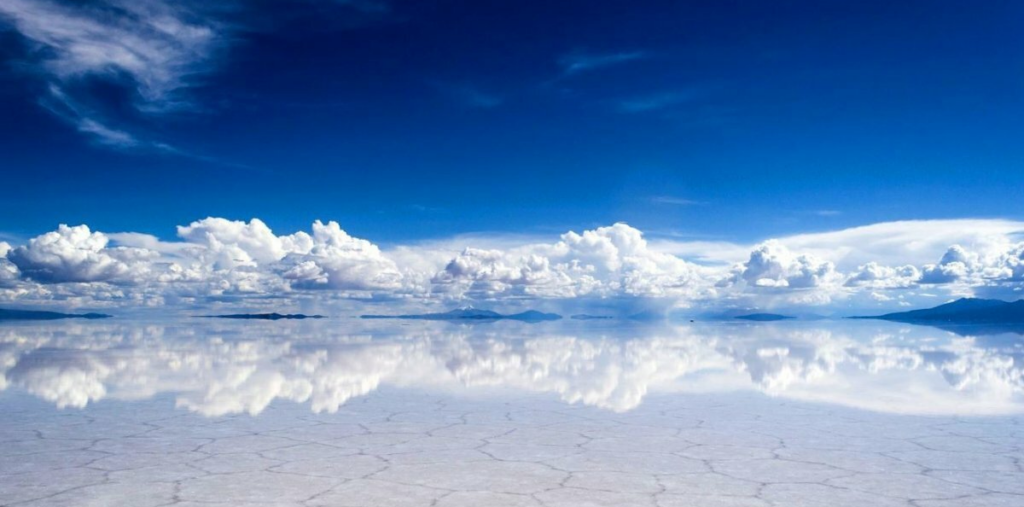Salar de Uyuni, located in Bolivia’s southwestern region, is a natural marvel that captivates travelers with its otherworldly beauty. It spans vast kilometers and transforms into a stunning reflective mirror during the rainy season. This salt flat is not just a tourist destination; it is also a vital geological and economic resource, making it one of the most fascinating landscapes in the world.
A Natural Wonder Born from Prehistoric Lakes
Salar de Uyuni originated from the transformation of ancient lakes that dried up thousands of years ago. These prehistoric bodies of water left behind a thick layer of salt, forming the iconic landscape we see today. Underneath the surface lies a reservoir of brine enriched with lithium, a critical element for modern technology.
This salt flat, the largest in the world, remains a geological gem. The region is home to unique flora and fauna adapted to the high-altitude and arid conditions. According to geological studies, the salt crust can extend several meters deep, highlighting the area’s natural significance.
A Photographer’s Paradise
Visitors from around the globe come to experience Salar de Uyuni’s enchanting scenery. During the rainy season, typically between November and March, the salt flat transforms into a massive mirror. This phenomenon happens when a thin layer of water accumulates on the surface, reflecting the sky and creating a surreal effect. Photographers and travelers often describe this as walking on clouds or stepping into a dreamlike world.

In the dry season, the area unveils another unique charm. The salt crust forms polygonal patterns stretching endlessly, offering a stark yet mesmerizing contrast to the sky. These visual spectacles make Salar de Uyuni a must-visit destination for anyone seeking unparalleled natural beauty.
Economic Significance of Lithium
Beyond its visual appeal, Salar de Uyuni holds immense economic potential. It is one of the richest sources of lithium, a critical component for batteries used in electric vehicles and electronic devices. Bolivia is actively working to harness these reserves, aiming to become a key player in the global lithium market.
However, lithium extraction poses challenges. The brine beneath the salt crust contains high magnesium levels, complicating the extraction process. Additionally, environmentalists and local communities emphasize the need for sustainable practices to preserve the region’s delicate ecosystem. A balance between economic development and environmental conservation is essential to protect this natural treasure.
Local Culture and Tourism
The salt flat is not just a geological or economic site; it is also deeply intertwined with Bolivian culture. Local communities, including the Quechua and Aymara people, have lived near this region for centuries. They maintain traditions tied to the land, offering cultural experiences to visitors.
The town of Uyuni serves as the gateway to this natural wonder. Tour operators provide a variety of excursions, from day trips to longer journeys that explore nearby attractions like the Train Cemetery and Eduardo Avaroa National Park. Whether you visit during the rainy or dry season, the area promises unforgettable experiences.
Sustainable Tourism and Conservation
As tourism grows, preserving Salar de Uyuni’s pristine environment becomes increasingly vital. Responsible tourism initiatives are in place to ensure visitors leave minimal impact. These efforts aim to safeguard the salt flat’s ecosystem while allowing future generations to witness its beauty.
Visitors can contribute by following eco-friendly practices, supporting local communities, and choosing sustainable tour operators. By respecting the natural and cultural heritage of the region, travelers can help preserve its magic.
Conclusion
Salar de Uyuni is more than just a salt flat; it is a symbol of natural beauty, geological wonder, and economic promise. Its reflective surface, formed during the rainy season, has earned it the nickname “the world’s largest mirror.” As Bolivia balances its rich lithium reserves with environmental preservation, the salt flat continues to inspire awe and wonder.
To truly appreciate Salar de Uyuni, one must visit and experience its breathtaking landscapes, rich culture, and unique ecological significance firsthand.
